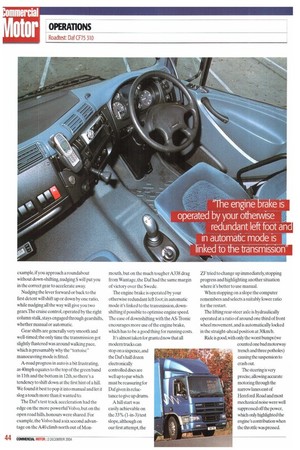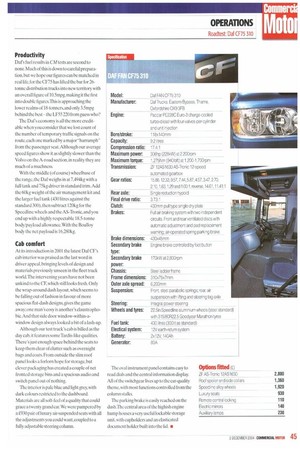MIDDLE OF THE ROAD
Page 42

Page 44

Page 45

If you've noticed an error in this article please click here to report it so we can fix it.
'Middle of the road' is sometimes used as an insult. But in the case of the 26-tonne three-axle Daf CF75 it means a truck that is perfectly specced for its distribution role.
Looking at the positioning of the CF75 310 6x2 in Dal's great scheme of things and it's a surprise we didn't complete the whole test route in the middle of the road. The CF cab is in the middle of the range, between LF and XF: the 9.2-litre engine that makes it a 75 is likewise sandwiched by the 5.9-litre 65 and the 12.6-litre 85.And just for good measure, we had the middle number of axles available (three) and, at 306hp, the middle engine rating.
Look down any high street and it won't be long before a six-wheeler is seen delivering the country's staple needs. But despite the contribution made to the UK economy by the sector, this CF75 is only the third 26-tonne distribution truck to have appeared on UK press test fleets in recent years, the other two hailing from Sweden.
This example is ideally specified for the distribution role, with ZF's AS-Tronic providing automated two-pedal transmission, and a steering third axle providing much of the manoeuvrability of an 18-tonner.And this is achieved with nearly eight metres of body length and a net payload of 16 tonnes The body is a Boalloy curtainsicier with a highly effective air-operated curtain tensioning system which kept the sides as flat as a box van. A full complement of cab roof and body side air management kit helped it cleave its way through the West Country breezes.
On the road
Combining a relatively large engine and lightly stressed engine with a transmission that ensures the right gear is used at any time should be a recipe for a harmonious mixture, and the Daf didn't disappoint.
The latest incarnation of ZF's AS-Tronic 12speeder has been made even easier to operate. Its primary control is a simple rotary knob to the left of the driving seat, marked R-N-D with a tortoise symbol at each end. This is backed up by a secondary function lever in the conventional gearstick position. Nudging the lever to the left cycles between the selfexplanatory A and M modes; to the right there's a position marked S.This stands for Search, and it's used in manual mode to find the optimum gear in a hurry. For
air management kit t roug t e West
example, if you approach a roundabout without down-shifting, nudging S will put you in the correct gear to accelerate away.
Nudging the lever forward or back to the first detent will shift up or down by one ratio, while nudging all the way will give you two gears.The cruise control, operated by the right column stalk, stays engaged through gearshifts, whether manual or automatic.
Gear shifts are generally very smooth and well-timed; the only time the transmission got slightly flustered was around walking pace, which is presumably why the "tortoise" manoeuvring mode is fitted.
A-road progress in auto is a bit frustrating, as 40mph equates to the top of the green band in 11th and the bottom in 12th, so there's a tendency to shift down at the first hint of a hill. We found it best to pop it into manual and let it slog a touch more than it wanted to.
The Dal's test track acceleration had the edge on the more powerful Volvo, but on the open road hills, honours were shared. For example, the Volvo had a six second advantage on the A40 climb north out of Mon mouth, but on the much tougher A338 drag from Wantage, the Daf had the same margin of victory over the Swede.
The engine brake is operated by your otherwise redundant left foot; in automatic mode it's linked to the transmission, downshifting if possible to optimise engine speed. The ease of downshifting with the AS-Tronic encourages more use of the engine brake, which has to be a good thing for running costs.
It's almost taken for granted now that all modern trucks can stop on a sixpence, and the Dafshaff dozen electronically controlled discs are well up to par which must be reassuring for Daf given its reluctance to give up drums.
A hill start was easily achievable on the 33% (1-in-3) test slope, although on our first attempt, the ZF tried to change up immediately, stopping progress and highlighting another situation where it's better to use manual.
When stopping on a slope the computer remembers and selects a suitably lower ratio for the restart The lifting rear-steer axle is hydraulically operated at a ratio of around one third of front wheel movement, and is automatically locked in the straight-ahead position at 30kni/h.
Ride is good,with only the worst bumps (we counted one bad motorway trench and three potholes) causing the suspension to crash out.
The steering is very precise, allowing accurate motoring through the narrow lanes east of Hereford. Road and most mechanical noise were well suppressed off the power, which only highlighted the engine's contribution when the throttle was pressed.
Productivity Des fuel results in CM-tests are second to none. Much of this is down to careful preparation,but we hope our figures can be matched in real life,for the CF75 has lifted the bar for 26tonne distribution trucks into new territory with an overall figure of 10.5mpg,making it the first into double figures.This is approaching the lower realms of 18-tonners, and only 35mpg behind the best the LF55 220 from guess who?
The Dal's economy is all the more creditable when you consider that we lost count of the number of temporary traffic signals on the route,cach one marked by a major "harrumph" from the passenger seat.Although our average speed figures show it as slightly slower than the Volvo on the A-road section, in reality they are much of a muchness.
With the middle (of course) wheelbase of the range, the Dal weighs in at 7,494kg with a full tank and 75kg driver in standard trim. Add the 60kg weight of the air management kit and the larger fuel tank (430 litres against the standard 300), then subtract 120kg for the Speedline wheels and the AS-Tronic, and you end up with a highly respectable 18.5-tonne body/payload allowance.With the Boalloy body the net payload is 16,280kg.
Cab comfort
At its introduction in 2001 the latest Daf CF's cab interior was praised as the last word in driver appeal, bringing levels of design and materials previously unseen in the fleet truck world.The intervening years have not been unkind to the CF, which still looks fresh. Only the wrap-around dash layout, which seems to be falling out of fashion in favour of more spacious fiat-dash designs, gives the game away; one man's cosy is another's claustrophobic. And that side door window-within-awindow design always looked a bit of a lash-up.
Although our test truck's cab is billed as the day cab, it features some Tardis-like qualities. There's just enough space behind the seats to keep them clear of clutter such as overnight bags and coats.From outside the slim roof panel looks a forlorn hope for storage, but clever packaging has created a couple of net fronted storage bins and a spacious audio and switch panel out of nothing.
The interior is pale blue and light grey,with dark colours restricted to the dashboard. Materials are all soft-feel of a quality that could grace a twenty grand car. We were pampered by a £930 pair of luxury air-suspended seats with all the adjustments you could want,coupled to a fully adjustable steering column. The oval instrument panel contains easy to read dials and the central information display. All of the switchgear lives up to the car-quality theme,with most functions controlled from the column stalks.
The parking brake is easily reached on the dash.Thc central area of the highish engine hump houses a very useful lockable storage unit, with cupholders and an elasticated document holder built into the lid. •




















































































































































































